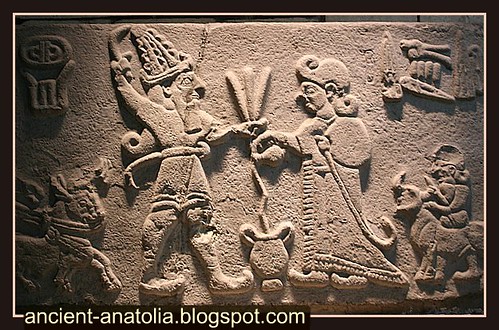
Ancient Hittite god facing right, bearded and with long, curled pig tail, wearing pointed, horned helmet, short sleeved, belted, bordered tunic and boots with upturned toes, curved sword with crescent pommel in belt, holding in right handraised behind him a boomerang(?), in left hand before him a 3-pronged object.
A similarly accoutred god, facing right, in a 2-wheeled cart, with body in form of a bird, drawn by two harnessed bulls, presumably represents the same god, driving up, then arrived.
Bare-headed, beardless man, with hair curled up on forehead and nape of neck, facing left wearing long, fringed garment, and shoes with upturned toes, holding in his right hand a jug from which he pours a libation into a 2-handled bowl on the ground, in his left hand a lituus pointing back and downwards; behind him, facing left.
A small bare-headed, beardless attendant holds a sacrifice bull.
Inscriptions; between the 2 figures of the god above the bulls, a two sign group; "Storm-God", behind the king above the attendant a 6-sign group; "PUGNUS-mili Potent(?) King" both inscriptions are epigraphs identifying the figures.
Corpus of Hieroglyphic Luwian Inscriptions I-II-III, John David Hawkings, 2000, Walter de Gruyter.
Hittite Sculpture and explanation at Museum of Anatolian Civilizations at Ankara.
PHOTO: Hittite Libation Scene, originally uploaded by voyageanatolia.blogspot.com.